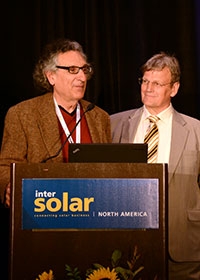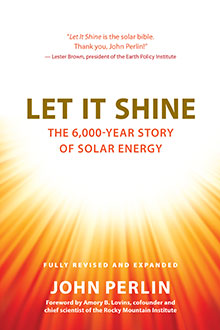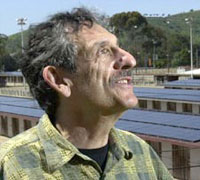 |
John Perlin Author, Lecturer, Consultant — Solar Energy & Forest Preservation Phone: 805.569 2740 • eMail: johnperlin@physics.ucsb.edu |

Links To Articles
First Silicon Solar Cell Patent
National Geographic
Article on Let It Shine
Mother Earth News
Article on Let It Shine
Socrates did not Invent Solar Architecture
John Perlin Interviewed on National Public Radio
A Forest Journey:
The Role of Wood in the Fate of Civilization
By
John Perlin
Ten thousand years ago forests covered 60% of the world’s habitable land. Since the advent of civilization 5,000 years ago, the Earth has lost almost a third of those forests. John Perlin’s enlarged and updated edition of A Forest Journey: The Role of Wood in the Fate of Civilization documents this tragedy, according to the BBC, by taking “One of those bold imaginative sweeps through history that leaves you full of excitement, as suddenly events seem to fall into a pattern for the first time. In a nutshell, John Perlin’s argument is that civilizations rose and fell because each began with a plentiful forest resource, used it up, and was extinguished – to be succeeded by a newer center, closer to a new rich swathe of forest. Perlin not only presents us with a bold hypothesis profusely documented and illustrated, he does it with a story-teller's pace and ability to surprise.”
A Climate History Classic
The extensive history of forests, from the distant past to our current climate chaos, and the little recognized role wood products served in the development of human civilizations is the life’s work of author John Perlin. Perlin’s book couldn’t be more timely, given its emphasis on mitigating climate change by renewing our symbiotic relationship with the trees that have sustained us. A Forest Journey is an approachable, accessible monograph with an impressively broad scope. From construction to fuel to weaponry, Perlin shows that wood may be humanity’s most essential material.” — Los Angeles Times 2/10/2023
Where civilizations rise, forests flee. And where forests founder, civilizations fall. That is the premise of A Forest Journey: The Role of Trees in the Fate of Civilization (Patagonia, 2023), a masterpiece by John Perlin, Simply put, “wood was the foundation upon which most societies were built,” Perlin writes. A Forest Journey” is as ambitious and comprehensive as its title suggests, imbued by its author with 40 years of expertise. The book spans the depths of human civilization, touching occasionally even further, to prehistoric events and the progenitors of our planet’s trees 385 million years ago. – University of California Santa Barbara
For more information on the enlarged and updated edition of A Forest Journey, listen to John Perlin interviews:
Have You Heard of Eunice Foote,
The Woman Who Discovered
Global Warming in 1856?
By John Perlin
Copyright, John Perlin, 2019
A Proposal for a New Book on the
Woman Who Laid the Foundation of the Science of Climate Change
163 Years Ago.
By all rights, Eunice Newton Foote should be a household name.
Foote was the first person to demonstrate that carbon dioxide is a greenhouse gas, and also the first person to suggest that high levels of carbon dioxide in our atmosphere would lead to a hotter earth. And yet relatively few people have heard of her.
Her research findings, contained in the paper, “Circumstances affecting the heat of the sun’s rays,” were presented at the August 23, 1856, annual meeting of the American Association for the Advancement of Science and published in the November 1856 issue of the American Journal of Science.
A man, John Tyndall, who came up with the same ideas five years later, has universally been recognized for these discoveries.
Writing Have You Heard of Eunice Foote has been like revealing that a woman, not Charles Darwin, came up with the idea of evolution sometime earlier, as Foote’s discoveries are foundational for today’s climate change science and the existential health of our home – Planet Earth.
Have You Ever Heard of Eunice Foote hopes to right this scientific wrong by describing her development as a scientist, which includes the beginning of science in America and of modern chemistry in particular; the rise of feminism against the backdrop of societal misogyny; and the fatal flaw of industrialization which now impacts us all.
Foote, who ranks as North America’s first female physicist of note, was also one of the principals in the first Woman’s Rights Convention in 1848. In fact, not only was her paper on Global Warming the first female-authored piece ever presented at an annual meeting of the American Association for the Advancement of Science, but her scientific writings remained the only articles by a woman in the field of physics published in respected science journals until the end of the nineteenth century.
No explanation for her obscurity is needed other than that she was a woman at a time when women were universally denied their inalienable rights.
Let It Shine:
The 6000-Year Story of Solar Energy
By
John Perlin
With a Foreword by Amory Lovins
The New and Expanded Edition
Praise for Let It ShIne
“John Perlin is the historian of solar energy. He now takes the history back thousands of years to early Chinese architecture and the yang-sui, the little bronze mirrors boys used to start the family fire, to nineteenth-century inventors who feared that coal supplies were about to run out, to modern passive solar buildings and today’s falling costs and growing use of photovoltaics. He does all this with a penchant for the diverse characters along the journey and with remarkable illustrations that vividly capture the six-thousand-year story of solar energy.”
— Daniel Yergin, Pulitzer Prize–winning author of The Quest: Energy, Security, and the Remaking of the Modern World and The Prize: The Epic Quest for Oil, Money, and Power.
“With remarkable depth, breadth, and precision, John Perlin lays out humankind’s long reliance on the sun before the carbon era and points the way to a healthy, comfortable, productive, resilient solar-powered world. There is more intelligence and common sense in this volume than in all the federal reports on energy of the last quarter-century combined.”
— Denis Hayes, former director of the federal Solar Energy Research Institute and founder of the Earth Day Network.
“The authoritative background story behind the worldwide solar revolution, Let It Shine is a story of human ingenuity and perseverance told with clarity and depth. The next chapter is ours to write.”
— David W. Orr, professor of environmental studies and politics at Oberlin College and author of Down to the Wire: Confronting Climate Collapse.
“Let It Shine makes it abundantly clear that solar energy has a long and glorious past — a prologue, in fact — that is as bright and diverse as its future will be. Far from being a disruption of the current energy economy, solar power can be harnessed in thousands of ways, making it easy to embrace and integrate into our future, as this book brilliantly demonstrates.”
— Daniel M. Kammen, distinguished professor of energy at the University of California, Berkeley.
“Let It Shine shows how today’s renewable revolution builds on the tenacious efforts of countless generations of innovators whose vision we may finally be privileged enough to bring to full flower.”
— from the foreword by Amory B. Lovins, cofounder and chief scientist of the Rocky Mountain Institute.
Many believe that solar energy is a twentieth-century phenomenon. What a surprise to discover that six thousand years ago the stone-age Chinese built their homes so every one of them made maximum use of the sun’s energy in winter. So begins the story of the genesis of solar energy told in Let it Shine: The 6000-Year Story of Solar Energy, the world’s first and only comprehensive history of humanity’s use of the sun for its betterment. Page after page the story brings to light information never before unearthed.
2500 years ago, for example, the sun heated every house in most Greek cities. Years later Roman architects published solar self-help books to show people how to save on fuel as firewood became scarce, and fleets scoured the known world for much needed supplies. During the renaissance Galileo and his contemporaries planned the construction of sun-focusing mirrors as the ultimate weapon to burn enemy fleets and towns.
Leonardo entertained more peaceful applications. He aimed at making his fortune by building mirrors a mile in diameter to heat water for the woolen industry. Much later, during the industrial revolution, engineers devised solar-run steam engines to save Europe from paralysis should it run out of fossil fuels.
As electricity began to power cities, the first photovoltaic modules joined the grid on a New York City rooftop in 1884. More than 100 years earlier a Swiss polymath modeled global warming by trapping solar heat in a glass-covered box just as carbon dioxide holds in solar heat above the earth. Using the same type of glass-covered box to harvest solar energy, enterprising businessmen established a thriving solar water industry in California beginning in the 1880s!
These are but a sampling of what’s to be found in the pages of Let it Shine.
Let it Shine presents the step-by-step development of solar architecture and technology, providing the background, and in the process, a deeper understanding, of how solar energy applications have emerged, and performed. The book is not merely a technological treatise though. It highlights the context in which these developments occurred and the people who have made the solar revolution possible, revealing a whole new group of unknown technological pioneers, as well as people famous for other accomplishments never before known for their work as the solar advocates and technologists they were.
Who would think Socrates as a solar promoter? Yet in a work by his admirer Xenophon Socrates presents the basic plans for designing a solar house. Vitruvius, a Roman famous to this day especially among architects, transmitted the wisdom of the Greeks on building with the sun. Then there are the forgotten ones like Gustav Vorherr, who opened up the first school of solar architecture during the 1820s in Munich. Thousands of newly trained solar architects fanned out to build solar homes in Europe throughout Europe in the nineteenth. Sympathetic despots of Bavaria and Prussia required their subjects to build following these solar building principals, resulting in population centers becoming sun cities. Who has heard of Williams Grylls Adams and Richard Evans Day, discoverers in 1876 of photovoltaics?
Let it Shine tells this unknown story never heard before. It shows from experience what a solar future might look like.
Chapter summaries of Let it Shine are here.
Publications
Books

A Forest Journey: The Role of Wood in the Fate of Civilizationy, John Perlin, author

Let It Shine: The 6000-Year Story of Solar Energy, (John Perlin, sole author), available in bookstores mid September, 2013 for $29.95 and online from the sellers here:
From Space to Earth: The Story of Solar Electricity. Ann Arbor, MI: aatec publications, 1999 (cloth); Harvard University Press, November, 2002 (paper) [Translated into Italian and serialized in Photovoltaic Magazine]
A Forest Journey: The Story of Wood and Civilization. New York: W. W. Norton & Company, 1989 (cloth); Cambridge, MA: Harvard University Press, 1991, 5th Printing, 2001 (paper). New Norton Edition, Countryman Press Imprint, fall, 2005. [Translated into Japanese, Portuguese, and Spanish]
A Golden Thread: 2500 Years of Solar Energy. (With Ken Butti.) New York: Van Nostrand Reinhold, 1980. [Translated into Japanese and Spanish]
Articles
Over thirty published articles in the following publications: Ad Astra, American Heritage’s Invention & Technology, Chicago Magazine, CoEvolution Quarterly (now Whole Earth Review), Home Power, Journal of Science Education and Technology, New Shelter, Refocus Solar Age, Solar Law Reporter, Solar Today, Whole Earth Review, & World & I.
Op-Ed Pieces
“Solar Electricity Could Help California,” San Diego Union-Tribune, December 27, 2000.
“The Tree of Life,” Santa Barbara News-Press, “Voices from Santa Barbara,” April 19, 2000.
“Letting the Sun Shine on Our Energy Needs,” Santa Barbara News Press, “Perspectives,” August 22, 1999.
Brochures
Understanding Solar Electricity, 2003; Californiasolarcenter.org.
Awards
London Times Book Review’s "Editor's Intersting Hardbacks -1990: A Forest Journey.
Publication of the Year—1990: A Forest Journey. The Geographic Society of Chicago.
Selection – 1991 “Sampler of the worldwide whirl planned for EarthDay- Time Magazine
Harvard University Press Classic in Science and World History: A Forest Journey -1996
Harvard University Press 100 Books for Every Reader’s Bookshelf: A Forest Journey -2004
Harvard University Press 100 Great Books: A Forest Journey- 2004
Documentaries
The Power of the Sun: One Century since Einstein’s Photon/A Half Century of Modern Photovoltaics. Principal Researcher, Narrative and Script Writer. University of California, Santa Barbara, Department of Physics/Inca Productions, Mill Valley, California. August 2003 - July 2005.
Sunrise. Narrator, and Consultant, Provided Script/Images. U.S. Department of Energy's Million Solar Roof Program & Arizona Department of Commerce Energy. April, 2003 (for streaming video, see www.jpc.uni-linz.ac.at/os/indes-os.html ["History of Solar Cells (John Perlin)].
© Copyright 2000 - 2023 All rights Reserved John Perlin
